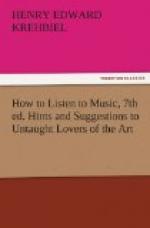because it is universally felt. More than speech,
if its primitive element of emotionality be omitted,
more than the primitive language of gesture, music
is a natural mode of expression. All three forms
have attained their present stage of development through
conventions. Articulate speech has led in the
development; gesture once occupied a high plane (in
the pantomimic dance of the ancients) but has now
retrograded; music, supreme at the outset, then neglected,
is but now pushing forward into the place which its
nature entitles it to occupy. When we conceive
of an art-work composed of such elements, and foregoing
the adventitious helps which may accrue to it from
conventional idioms based on association of ideas,
we have before us the concept of Absolute music, whose
content, like that of every noble artistic composition,
be it of tones or forms or colors or thoughts expressed
in words, is that high ideal of goodness, truthfulness,
and beauty for which all lofty imaginations strive.
Such artworks are the instrumental compositions in
the classic forms; such, too, may be said to be the
high type of idealized “Programme” music,
which, like the “Pastoral” symphony of
Beethoven, is designed to awaken emotions like those
awakened by the contemplation of things, but does
not attempt to depict the things themselves.
Having mentioned Programme music I must, of course,
try to tell what it is; but the exposition must be
preceded by an explanation of a kind of music which,
because of its chastity, is set down as the finest
form of absolute music. This is Chamber music.
[Sidenote: Chamber music.]
[Sidenote: History of the term.]
[Sidenote: Haydn a servant.]
In a broad sense, but one not employed in modern definition,
Chamber music is all music not designed for performance
in the church or theatre. (Out-of-door music cannot
be considered among these artistic forms of aristocratic
descent.) Once, and indeed at the time of its invention,
the term meant music designed especially for the delectation
of the most eminent patrons of the art—the
kings and nobles whose love for it gave it maintenance
and encouragement. This is implied by the term
itself, which has the same etymology wherever the
form of music is cultivated. In Italian it is
Musica da Camera; in French, Musique de
Chambre; in German, Kammermusik. All
the terms have a common root. The Greek [Greek:
kamara] signified an arch, a vaulted room, or a covered
wagon. In the time of the Frankish kings the
word was applied to the room in the royal palace in
which the monarch’s private property was kept,
and in which he looked after his private affairs.
When royalty took up the cultivation of music it was
as a private, not as a court, function, and the concerts
given for the entertainment of the royal family took
place in the king’s chamber, or private room.
The musicians were nothing more nor less than servants




